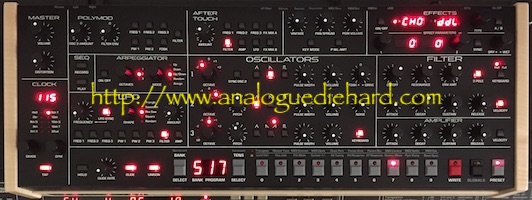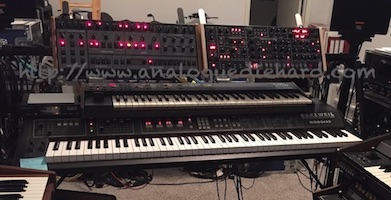Sequential Trigon-6 Analog Polyphonic Synthesizer
Last Update 03/12/2024
My Memorymoog
set a pretty high bar in my arsenal with its sound/voice
modulation. It was the machine where I learned a lot of sound
design and I got a lot of mileage out of it. I had wanted to
reduce the size and weight of my stage system and I had to have those
sounds. Plus I wanted something with much better MIDI
implementation (the only really good retrofit is the wonderful and $$$$
LAMM upgrade), and without the headache of frequent tuning
calibration.
Since ~1990 I have been looking for something more portable (hardware)
that could get me those sounds. It was a long long search - most
products with similar feature set did not make the cut. Some had
three VCOs but lacked the vintage sound I wanted. Some had decent
modulation options but only two VCOs. Some had three VCOs and
good modulation options but not the vintage sound. Very high
standard to meet. I acquired my Alesis Andromeda in 2001
which could
emulate most but not all the MM sounds I programmed. It was a
compromise with only two VCOs but it delivered that vintage sound and
had an extensive modulation feature set. Alas after 20 years of
use, it was starting to show its age as it would occasionally crash in
the middle of a song on stage. So it was time to retire the
Andromeda from the stage.
But there was no way that anybody was going to make a hardware clone of
the Andromeda especially with its extensive modulation options (I
refuse to use a laptop or mobile on a stage). The Andromeda
benefitted from the custom ASIC talents of the late Keith Barr which
packed a lot of features in a small package. I built a library of
synth sounds using the Andromeda and desired to duplicate them, so I
decided the only replacement was multiple synths. That meant the
replacements have to be very compact for stage use, as I didn’t want my
stage rig to get too big. Sequential had been building very good
sounding polysynths. They often follow a new product release with
a desktop model, which I saw as a compact solution (I really preferred
a rack mount model). Mind you they’re not going to clone the
Andromeda, but starting in 2013 Sequential was gradually getting closer
to
that “vintage” sound - they got really close with the P-6 introduced in
2016, but not quite. Then the Trigon-6 was introduced in 2022 and
knocked it out of the park.
The Trigon-6 not only emulates the Memorymoog really well and delivers
that vintage ladder filter sonority, it has a lot of other tricks it
can do. Very welcome additions are much better MIDI implementation
(including patch sysex and polyAT), filter feedback, overdrive,
velocity control, sequencer/arpeggiator sync’d to internal or MIDI
clock, and digital effects. For those who are curious how the
Memorymoog features compare to the T-6, I tabulated them in these
tables. The differences
are in red text.
I know the hardware engineer on the Sequential staff and he confirmed
that the
Trigon voice card is designed after the Memorymoog voice card (he also
owns a Memorymoog). With a few exceptions it’s not hard to
duplicate Memorymoog patches, but the T-6 does better than my
Andromeda. The majority of the pots are rotary with a few endless
encoders.
The user interface is a generous panel full of single-function knobs
and buttons, with no “menu-diving”. I had been moving away from
user interfaces with an LCD display as these are proving to have a
short life and will become harder to replace, especially the graphic
displays. For a long time I have hated user interfaces with only
a single control (or plus/minus buttons) and an LCD “menu” system as
they are too hard to manipulate patches and they destroy that precious
moment of inspiration. And editing software for computers were
never a good solution (computer OS often become obsolete within five
years, along with the software editor). Those button/LCD
interfaces were designed for maximum bang for the buck to outprice
competitors but ultimately proved unpopular with musicians, and a
single control for editing suffers far more use which will wear out
much sooner (good luck replacing a slidepot control). Many menus
were “user hostile” with poor organization. Musicians started
demanding full panel single-function control user interfaces starting
in the 1990s when the vintage analog synth renaissance started, and
Sequential
responded to that. Adding controls with associated components
costs more, and it is amazing that Sequential provided that user
interface
while keeping the price reasonable.
Yes my studio contains some devices with these "user hostile"
interfaces. However they are devices with shallow menus, or are
devices whose libraries I had built long ago and no longer need to edit
them.
I'm not normally a fan of on-board effects but these are well thought
out selections, very suitable for an analog synth. Effects like
the phasers have an uncanny vintage quality to them that surprised an
analog diehard like myself. For too long, digital emulations of
analog effects like phasers, flangers, and chorus lacked the “dirt” of
the real analog device. Digital effect emulations relied on an
abstract textbook model which resulted in an effect that sounded too
clean; it wasn’t until now that designers built in “imperfections” in
the model that added the “dirt” that can really spice up a synth
patch. The T-6 offers two delay effects - digital and (again, for
that “dirt” that musicians like) a BBD type that isn’t “perfect” but
many claim it sounds “warmer” - and the delay time can be sync’d to the
sequencer/arpeggiator or MIDI clock. The Ring Modulator is more
useful than most synths that feature one. Digital reverbs are
limited to Hall, Plate, Room, and Spring. They may be rudimentary
but we’re not trying to emulate the Boston Symphony Hall. The
reverbs I often use on analog synths are ambient or room algorithms
with very short tails - I seldom use reverbs with long tails.
Plate reverbs work well with brass sounds, Hall reverb with string
sounds. I would had preferred more controls for the effects, but
the user interface is intuitive and I have other resources for those
rare occasions where I need better effects. Sequential made a
good move
providing TWO digital effect generators with FX “A” feeding serially
into FX “B”, and when they are disabled the audio path bypasses the
digital conversion processing of the digital effects, keeping the audio
path true analog if one wishes.
The patch library holds 1000 patches, in 10 banks of 100 memory slots
each. Memory slots 500 to 999 are factory patches which cannot be
overwritten; the first 500 patch slots 0 to 499 are user memory and
contain duplicates of the 500 factory patches when the T-6 is delivered
new. The majority of the factory patches are targeted to the EDM
genre, there’s not many traditional “bread-n-butter” sounds or classic
synth sounds associated with popular songs. Thankfully Sequential
uses
the same Schadow momentary button switches found on their classic
Prophet-5 synth for patch selection. These have a far longer life
than the minuscule tactile momentary buttons (placed under panel
mounted actuators) used on too much gear, which have a history of
wearing out and cannot be restored.
I bought the desktop module - it is solidly built and the
controls/buttons aren't too crowded for stubby fingers. Besides
wanting a compact package, I wanted to reduce the number of keyboards
in my stage
rig. MIDI is heavily utilized in my stage system and
I wanted to control as much as my gear remotely over MIDI as
possible. This is
an addition to my two OB-X8 desktop modules that
comprise my stage rig
and this set will fill my gigging needs nicely (and replaces my aging
Andromeda). So with these modules, my stage system is reduced to
just two keyboards - my Kurzweil MIDIBoard (the
master MIDI controller) and my Hammond XK3, which can also
function as a second MIDI controller. I
also have a Moog
Taurus II Controller with MIDI retrofitted for those
songs where I need to play parts with my feet.
I have found
that the Oberheim filters and the Moog ladder filters co-exist nicely
together without a lot of overlap. The T-6 traditional
(-)24dB/oct ladder filter sounds amazingly like the vintage Moog
filter. While the T-6 filter does offer a (-)12dB/oct response,
it will not sound like the Oberheim (-)12dB/oct state variable
filter. Between these two, they cover a lot of synthesizer
timbres. The ratio of three Oberheim voices to one Memorymoog
voice
follows the convention I used often on my Andromeda - most of my
Andromeda setups were three Oberheim-styled patches and/or one
Moog-styled patch. The OB-X8 sounds excellent but has some gaps
that the
Trigon fills - IE voice modulation, VCF EG to modulate PW (the SEM had
it but omitted on the X8), aftertouch opens or closes the VCF (X8 only
opens the VCF, can't do brass sforzando effects).
Do I miss the omitted Memorymoog features like EG Keyboard
Follow? Well I'm having a hard time recalling ANY of my MM
patches where I used that feature - so I'm not crying over them.
I liked the MM Contoured OSC3 Amount feature omitted from the T-6
although I have that in the OB-X8 (see - the OB-X8 fills some gaps on
the T-6). The one enduring feature I am
pushing Sequential is VCF Keyboard Tracking - they implemented
off-half-full,
while the MM is off-1/3-2/3-full. I feel the MM implementation is
more flexible and really makes a difference with some patches being
playable across the entire keyboard range.
I reviewed the factory patches (all 500) and most
of them did not appeal to me. That doesn't mean they are bad -
many are targetted to EDM, and I like the old school 70s/80s
sounds. The T-6 definitely has some factory patches I can use,
and some patches really surprised me ("HOW did they do that on an
ANALOG SYNTH?!?"). I know some of the sound design team who built
the factory patches, so this is not meant to be any reflection on their
work. I'm looking forward to exploiting new features on the T-6
such as distortion and feedback which were not on the Memorymoog.
Some of the factory patches have a flaw - when I held the sustain pedal
down, the voice assignment did not retrigger past the sixth
voice. I reported it to support and they insisted this was how
voice assignment traditionally worked (WRONG). I did eventually
find a factory patch that did retrigger past six voices, so all is not
lost.
If you ever encounter a button that doesn't work, Sequential support
shared an easy fix. The buttons actually have a self-cleaning
action - repeatedly pressing the button ~50 times, or twisting it
side-to-side while holding it down, or applying extra pressure on the
button can resolve the problem. It does work!
Sequential has released a new firmware version that adds MPE, you can
find it on their website.
The best thing about the Trigon... no calibration or tuning foibles
(anyone who owns/owned a MM knows this too well). Calibration is
painless using the firmware.
Sequential is building really good products - they may not have every
feature
of other products, but they are enough and they fill a market need.
Check back for updates as I continue exploring this new toy.

Home




